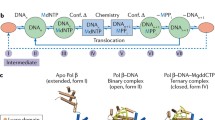Abstract
To investigate whether or not DNA polymerases α, δ, and ε from tumor cells have acquired properties that might be responsible for mutations found in tumor development, we investigated copying fidelities of DNA polymerases α, δ, and ε from the highly malignant Novikoff hepatoma cells and compared them to the corresponding enzymes from normal rat liver. DNA polymerases were purified more than 300-fold by three chromatographic steps. Copying fidelity was studied using steady-state kinetics and an 18-mer oligonucleotide primed with a 12-mer (13-mer for extension experiments) as DNA primer-template. Three experimental approaches were chosen: i) extension of DNA primers with mismatched 3’-OH ends opposite dGMP, ii) DNA insertion of nucleotides opposite m6G in the template and iii) extension of DNA primers with mismatched 3’-OH ends opposite m6G. i) Extension of DNA primers with mismatched 3’-OH ends opposite dGMP. DNA primer templates containing G:T and G:A mispairs at the 3’-OH position of the primer were easily extended by DNA polymerases α, δ and ε from both normal rat liver and Novikoff hepatoma cells. The G:G mismatch was elongated with low efficiency. Notably, DNA polymerase α from Novikoff hepatoma cells extended G:A and G:G mismatches significantly faster than the enzyme from normal cells. ii) Insertion of nucleotides opposite m 6 G. DNA polymerases α, δ, and ε from normal rat liver preferably catalyzed incorporation of dAMP opposite m6G at dNTP concentrations <100 μM. When dNTP concentrations were raised to ≥100 μM, dCMP (DNA polymerases δ and ε) and dTMP (DNA polymerase α) were also incorporated. The same insertion characteristics were found for the enzymes from Novikoff cells, however, insertion efficiencies of dAMP and dCMP were significantly higher for polymerases δ and ε. iii) Extension of primers with mismatched 3’-OH ends opposite m 6 G. Only m6G:dAMP and m6G:dCMP mismatches were extended by DNA polymerases α, δ and ε from both sources. No differences in extension efficiency were observed between the enzymes from normal and hepatoma cells. Taken together, our results suggest that DNA polymerases α, δ, and ε from Novikoff cells catalyzed incorporation of the wrong nucleotides more readily and extended mismatches more easily. These results may provide a rationale why numerous mutations accumulate during tumor development.
Similar content being viewed by others
Author information
Authors and Affiliations
Additional information
Received: 12 June 1997 / Accepted: 8 October 1997
Rights and permissions
About this article
Cite this article
Fox, G., Popanda, O. & Thielmann, H. Evidence for reduced copying fidelity of DNA polymerases α, δ, and ε from Novikoff hepatoma cells. J Cancer Res Clin Oncol 123, 659–668 (1997). https://doi.org/10.1007/s004320050121
Issue Date:
DOI: https://doi.org/10.1007/s004320050121



